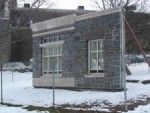A Mystery Solved: The Wall Behind Olin

With construction so rampant on campus this year, Colgate students were unfazed by the lone wall erected behind Olin Hall. However, as construction of the Robert H.N. Ho Science Center progressed, the wall grew increasingly detached from the project and ever more mysterious.
“The function of the fenced-in wall behind Olin Hall is to serve as a ‘mock-up’ for the construction crews and engineers involved in building the Ho Science Center,” G. Kirk Raab ’59 Associate Professor of Biology Damhnait McHugh said. “It serves as a way to ensure that the envelope of the building will be constructed to the highest standards and to meet all regulations.”
McHugh serves as the University liaison for the Ho Science Center project.
The fenced-in wall and area have been used to ensure that windows, for example, pass air and water tests. In having the “mock-up” exterior wall, construction crews are able to discover flaws in materials or equipment before having used them on the actual building.
These tests save both time and funds for the university and construction crews – if flaws were discovered after their installation on the Ho Science Center, building would become seriously delayed, a proposition most unwelcome on campus in light of delays during the construction of the new Case Library and Geyer Center for Information Technology
In addition to guaranteeing safety codes are met and timetables are kept on track, the “mock-up” was used by masons to be sure that the hue and coloring of the stone placed on the fa?cade of the Ho Science Center is in keeping with the rest of the buildings on campus, some of which were built over 100 years ago.
Also, to guarantee no materials go to waste, as many materials as possible will be “recycled” in the construction of the Ho Science Center.
“We also have a full mock-up of a research lab,” McHugh said. “It is located in Lathrop and has allowed faculty and staff to evaluate the casework and layouts that will be used in the labs.”







